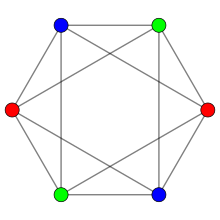Well-colored graph
In graph theory, a subfield of mathematics, a well-colored graph is an undirected graph for which greedy coloring uses the same number of colors regardless of the order in which colors are chosen for its vertices. That is, for these graphs, the chromatic number (minimum number of colors) and Grundy number (maximum number of greedily-chosen colors) are equal.[1]

Examples
The well-colored graphs include the complete graphs and odd-length cycle graphs (the graphs that form the exceptional cases to Brooks' theorem) as well as the complete bipartite graphs and complete multipartite graphs.
The simplest example of a graph that is not well-colored is a four-vertex path. Coloring the vertices in path order uses two colors, the optimum for this graph. However, coloring the ends of the path first (using the same color for each end) causes the greedy coloring algorithm to use three colors for this graph. Because there exists a non-optimal vertex ordering, the path is not well-colored.[2][3]
Complexity
A graph is well-colored if and only if does not have two vertex orderings for which the greedy coloring algorithm produces different numbers of colors. Therefore, recognizing non-well-colored graphs can be performed within the complexity class NP. On the other hand, a graph has Grundy number or more if and only if the graph obtained from by adding a -vertex clique is well-colored. Therefore, by a reduction from the Grundy number problem, it is NP-complete to test whether these two orderings exist. It follows that it is co-NP-complete to test whether a given graph is well-colored.[1]
Related properties
A graph is hereditarily well-colored if every induced subgraph is well-colored. The hereditarily well-colored graphs are exactly the cographs, the graphs that do not have a four-vertex path as an induced subgraph.[4]
References
- Zaker, Manouchehr (2006), "Results on the Grundy chromatic number of graphs", Discrete Mathematics, 306 (23): 3166–3173, doi:10.1016/j.disc.2005.06.044, MR 2273147
- Hansen, Pierre; Kuplinsky, Julio (1991), "The smallest hard-to-color graph", Discrete Mathematics, 96 (3): 199–212, doi:10.1016/0012-365X(91)90313-Q, MR 1139447
- Kosowski, Adrian; Manuszewski, Krzysztof (2004), "Classical coloring of graphs", Graph Colorings, Contemporary Mathematics, 352, Providence, Rhode Island: American Mathematical Society, pp. 1–19, doi:10.1090/conm/352/06369, MR 2076987
- Christen, Claude A.; Selkow, Stanley M. (1979), "Some perfect coloring properties of graphs", Journal of Combinatorial Theory, Series B, 27 (1): 49–59, doi:10.1016/0095-8956(79)90067-4, MR 0539075